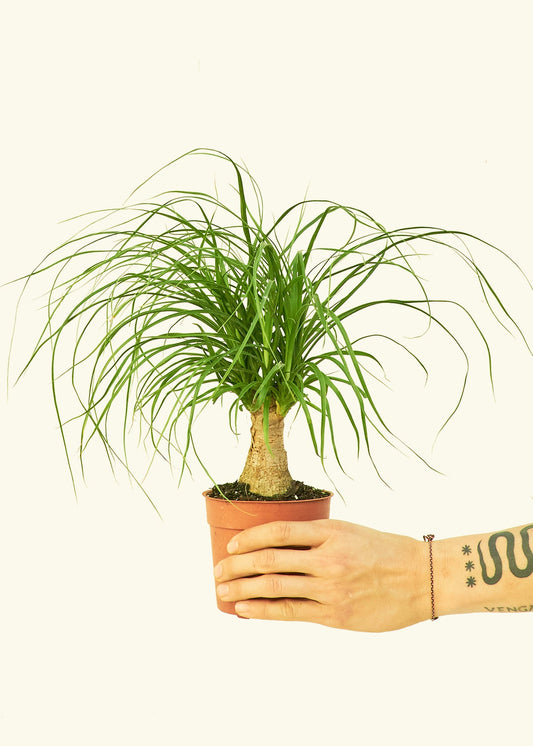Indoor Palm Trees: Overview
Get magnificent palm trees to create a calm, exotic atmosphere that will mentally transport you to faraway places and help you relax!
Palm plants are believed to have originated in Ancient Mesopotamia. Today, palms grow in tropical and subtropical regions all over the world, from Africa and the Middle East to Australia and South America. Most palm tree types are best suited to hardiness zones 10-12, where they flourish as porch plants, but some varieties are more tolerant of cold weather than others.
Palm trees are highly versatile; there are large and small palm trees, and different palm tree varieties have varying preferences in light and watering conditions. Most indoor palm trees are pet-friendly, which makes them ideal choices for homes with pets.
Palm trees symbolize abundance, endurance, and victory in various cultures and are associated with triumphs.
Benefits of Palm Trees
- Add tropical jungle vibes
- Easy to care for
- Pet-friendly houseplants
- Some varieties thrive in full sun
- Improve focus and mood
Indoor Palm Tree Care: Growing Tips
A couple of gorgeous indoor palms can turn your living space into a relaxing tropical oasis. This transformation doesn’t require a lot of effort, as palm tree care is simple. Here’s how to keep your palm trees flourishing:
Watering, Light, Humidity, and Temperature
Various types of palms have differing water needs. Most prefer slightly moist soil. However, some varieties are drought-tolerant and need less watering. Always check your particular palm’s needs and avoid overwatering.
Different types of indoor palm plants have varying light needs. Most palms will grow best in bright to medium indirect light. Direct sunlight can scorch your palm’s leaves. Still, some varieties, such as the Majesty Palm, can tolerate a few hours of full sun.
Many palms appreciate high humidity. Mist your palms regularly. Placing your palm tree on a pebble tray, using a humidifier, or grouping your palms with other houseplants can also help increase humidity levels indoors. As tropical plants, palms prefer temperatures ranging between 60-80°F. Temperatures below 50°F can damage the plants.
Repotting, Soil, and Feeding
Allow your palm tree time to adjust to the new environment. Palms need repotting every 3-4 years, as many of them grow slowly. Use a slightly larger pot each time.
Indoor palm plants thrive in well-draining soil that also retains moisture. Use a mix of potting soil and sand, adding perlite, bark, or coco coir for better soil aeration.
Most palm plants require feeding monthly during the growing season. Use a balanced, slow-release fertilizer specifically designed for palms to ensure that your plant gets the essential nutrients for even and lush growth.
Propagation
You cannot propagate your palm tree house plant from cuttings, like other plants. Some varieties can be propagated via division, but most are easiest to propagate from seeds. Gather them when ripe, plant in moist soil, and keep in warm temperatures.
Pruning, Cleaning, and Common Issues
Your indoor palm tree doesn’t require a lot of pruning. Simply remove dry, brown leaves. You can cut off the brown tips to keep your palm neat. Keep the soil clean from debris.
Always check your palm’s leaves for insects or disease. Remember that low humidity can lead to pest infestations. Brown leaf tips show that the palm needs more frequent watering or higher humidity.
Explore Our Collection of Different Types of Palm Trees
Transform your home with beautiful palm house plants available at Hey Rooted and enjoy their tropical charisma!
Parlor Palm
Description: The graceful Parlor Palm (Chamaedorea elegans) is one of the most adorable mini palm trees for your home, growing to 3-4 ft. tall when fully mature and thriving in low light.
Bamboo Palm
Description: Magnificent and lush, the Bamboo Palm (Areca Palm) has delicate, bamboo-like fronds and is renowned for its outstanding air-purifying properties.
Yucca Cane
Description: The sharp-leaved Yucca Cane (Yucca gigantea) is extremely low-maintenance and may produce clusters of butter-yellow flowers if placed outdoors in the warmer months.
Majesty Palm
Description: With stately, arched fronds, the Majesty Palm (Ravenea rivularis) makes a captivating floor plant; these large palm trees can grow to 8-10 ft. tall.
Shop Beautiful Palm Trees for Sale at Hey Rooted Today!



